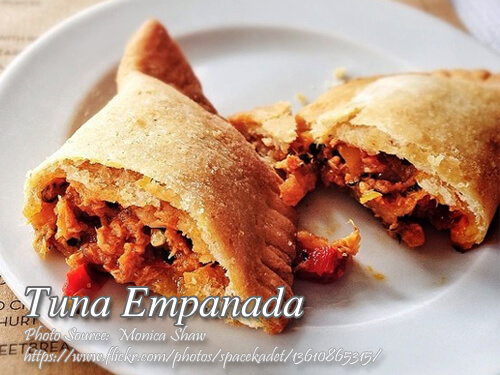Tuna empanada is one of the many varieties of empanada. Unlike pork, chicken or beef empanada, this is healthier because it uses tuna flakes which most of us know that it has Omega-3 oil that is good for the heart. In this recipe we used canned tuna instead of fresh tuna because it is easier and more suited to making empanadas. The recipe also used an Afritada mix and tuna instead of fresh tomatoes and tuna which is a popular combination of Spanish tuna empanada.
The Healthier Choice
Tuna empanada is a delightful variation of the traditional empanada, offering a healthier option compared to its pork, chicken, or beef counterparts. Tuna, known for its rich Omega-3 content, promotes heart health and is a nutritious alternative for those seeking a lighter yet equally satisfying meal. This recipe uses canned tuna for convenience, paired with an afritada mix to recreate the popular Spanish empanada flavor.
A Brief History of Empanadas
Empanadas have a rich history that traces back to the time of the Spanish colonization. The name “empanada” comes from the Spanish verb “empanar,” meaning to wrap or coat in bread. These pastries were introduced to Latin America and the Philippines by Spanish colonizers, and since then, they have been embraced and adapted to local tastes. Each region has developed its unique variations, with different fillings and preparation methods. This empanada is one such variation that reflects the influence of Spanish cuisine while incorporating local ingredients and preferences.
Preparing the Filling
The first step in making a delicious empanada is preparing the filling. Start by heating oil in a pan over medium heat. Sauté minced garlic and finely chopped onions for about two minutes until they become fragrant and slightly translucent. This combination of garlic and onion serves as the flavorful base for the filling.
Next, add the canned tuna flakes to the pan. Sauté the tuna for another two minutes to allow the flavors to meld. Using canned tuna is not only convenient but also ensures a consistent texture and taste, making it ideal for this recipe.
To create the sauce, dissolve an afritada mix in water and pour it into the pan. Afritada is a Filipino tomato-based stew, and the mix typically includes spices and seasonings that complement the tuna perfectly. Add diced potatoes to the pan and let the mixture simmer until the sauce thickens and the potatoes are tender. This step infuses the filling with a rich, savory flavor while giving it a hearty texture.
Incorporate raisins, green peas, and grated cheese into the mixture, allowing it to simmer for an additional two minutes. The raisins add a touch of sweetness, while the green peas provide a burst of color and freshness. The melted cheese binds the filling together, creating a cohesive and delicious mixture ready to be encased in the pastry.
Crafting the Perfect Pastry
Creating the perfect empanada pastry requires attention to detail and a bit of patience. Begin by combining flour, salt, and sugar in a large bowl. These dry ingredients form the foundation of the dough, ensuring it has the right balance of flavor and texture.
Add shortening to the flour mixture and blend it until the mixture holds together. The shortening helps create a flaky, tender crust, which is essential for a good empanada. Continue kneading the dough, adding water one tablespoon at a time until it becomes smooth and pliable. Once the dough reaches the desired consistency, form it into a ball.
To roll out the dough, dust a sheet of wax paper with flour and place the dough on top. Sprinkle more flour on the dough to prevent sticking. Place another sheet of wax paper on top of the dough and use a rolling pin to flatten it to about 1/4 inch thick. This method ensures an even thickness, which is crucial for the empanadas to bake or fry uniformly.
Using a cookie cutter mold, cut out 4-inch diameter circles from the rolled dough. These circles will be the individual empanada wrappers. The size is just right for holding a generous amount of filling without making the empanadas too large or difficult to handle.
Assembling the Empanadas
Now comes the fun part: assembling the empanadas. Place a tablespoonful of the prepared filling in the center of each dough circle. Be careful not to overfill, as this can make sealing the edges challenging.
Fold the dough over the filling to form a half-moon shape. To seal the edges, twist or flute them with your fingers, or use a fork to press the edges together. Ensuring a good seal prevents the filling from leaking out during cooking.
Arrange the assembled empanadas on a cookie sheet and brush the tops with egg wash. This step gives the empanadas a beautiful golden color and a slight sheen when baked.
Baking or Frying: The Final Touch
The final step in making empanadas is cooking them to perfection. You have the option to bake or deep-fry the empanadas, depending on your preference.
To bake, preheat your oven to 350°F and bake the empanadas for about 30 minutes or until they turn golden brown. Baking is a healthier option as it uses less oil and results in a slightly crispier crust.
Alternatively, you can deep-fry the empanadas until they are golden brown and crispy. Frying gives the empanadas a rich, indulgent flavor and a wonderfully flaky texture. Whichever method you choose, the result will be deliciously satisfying empanadas that are sure to please.
Tuna Empanada: A Heart-Healthy Delight
Tuna empanadas are a versatile dish that can be enjoyed as a snack, appetizer, or even a main course. Their combination of savory tuna, hearty potatoes, and a hint of sweetness from raisins makes them a unique and flavorful treat. Whether you are looking for a healthier alternative to traditional empanadas or simply want to try something new, tuna empanadas are a delightful choice. Enjoy them fresh out of the oven or fryer, and savor the delicious fusion of flavors in every bite.
How to Make Tuna Empanada
Ingredients
- 2 Tbsps. cooking oil
- 1 pc onion diced
- 2 Tbsps. garlic minced
- 2 180 grams cans tuna flakes in oil, drained
- 1 small pouch afritada mix dissolved in 1 cup water
- 1/8 cup cooked or canned green peas
- 1 cup potatoes diced, about half inch cube
- 1/8 cup raisins
- 1/8 cup grated cheese
Ingredients for the pastry:
- 2 1/2 cups flour
- 1 Tbsp. sugar
- 1 tsp. salt
- 8 Tbsps. ice cold water
- 12 Tbsps. shortening
Instructions
To make the filling:
- In a pan heat oil, sauté garlic and onion for 2 minutes. Add tuna flakes, sauté for 2 minutes.
- Add the dissolved afritada mix and potatoes. Simmer until sauce thickens.
- Add the raisins, green peas and grated cheese simmer for 2 minutes.
To make the Pastry:
- In a large bowl, combine flour, salt, and sugar together.
- Add the shortening to flour mixture and blend it until the mixture holds together.
- Continue kneading and add water one tbsp at a time until the mixture turns into a smooth dough then form a into ball.
- Dust flour into wax paper and place the dough on top and sprinkle with flour.
- Place another wax paper on top. Using a rolling pin, start with the center of the dough until it reaches to the edges with small rolling strokes until the dough is flattened into 1/4 inch thick.
- Cut out 4 inch diameter circles using a cooking cutter mold on the dough.
To assemble the Empanada:
- Place 1 tablepoonful of the prepared filling at the center of each piece of dough.
- Fold it forming half moon shape pieces. Twist or flute the edges to seal completely. You can also use a fork and seal the edges by pressing the edges.
- Arrange them on cookie sheet and brush top with eggwash.
- Bake at 350°F for about 30 minutes or deep fry until golden brown. Makes 10 to 12 pcs.
Notes
Cooking Tips:
Ensuring a Flaky Crust
To achieve a flaky crust, ensure that the shortening is well-incorporated into the flour mixture until it resembles coarse crumbs. This step is crucial as it creates pockets of fat that melt during baking, resulting in a tender, flaky texture. Additionally, handle the dough as little as possible to prevent overworking, which can make the crust tough.Perfecting the Filling Consistency
Simmer the filling until the sauce thickens and the potatoes are tender, ensuring a cohesive and flavorful mixture. If the filling is too watery, it may cause the empanada to become soggy and difficult to handle. Let the filling cool slightly before assembling to make it easier to work with and to avoid breaking the dough.Achieving a Golden Finish
Brush the empanadas with an egg wash before baking to give them a beautiful, golden-brown finish. The egg wash also helps to seal any small cracks in the dough, preventing the filling from leaking out during cooking. For an extra crispy texture, consider sprinkling a light layer of coarse salt or sesame seeds on top before baking.





